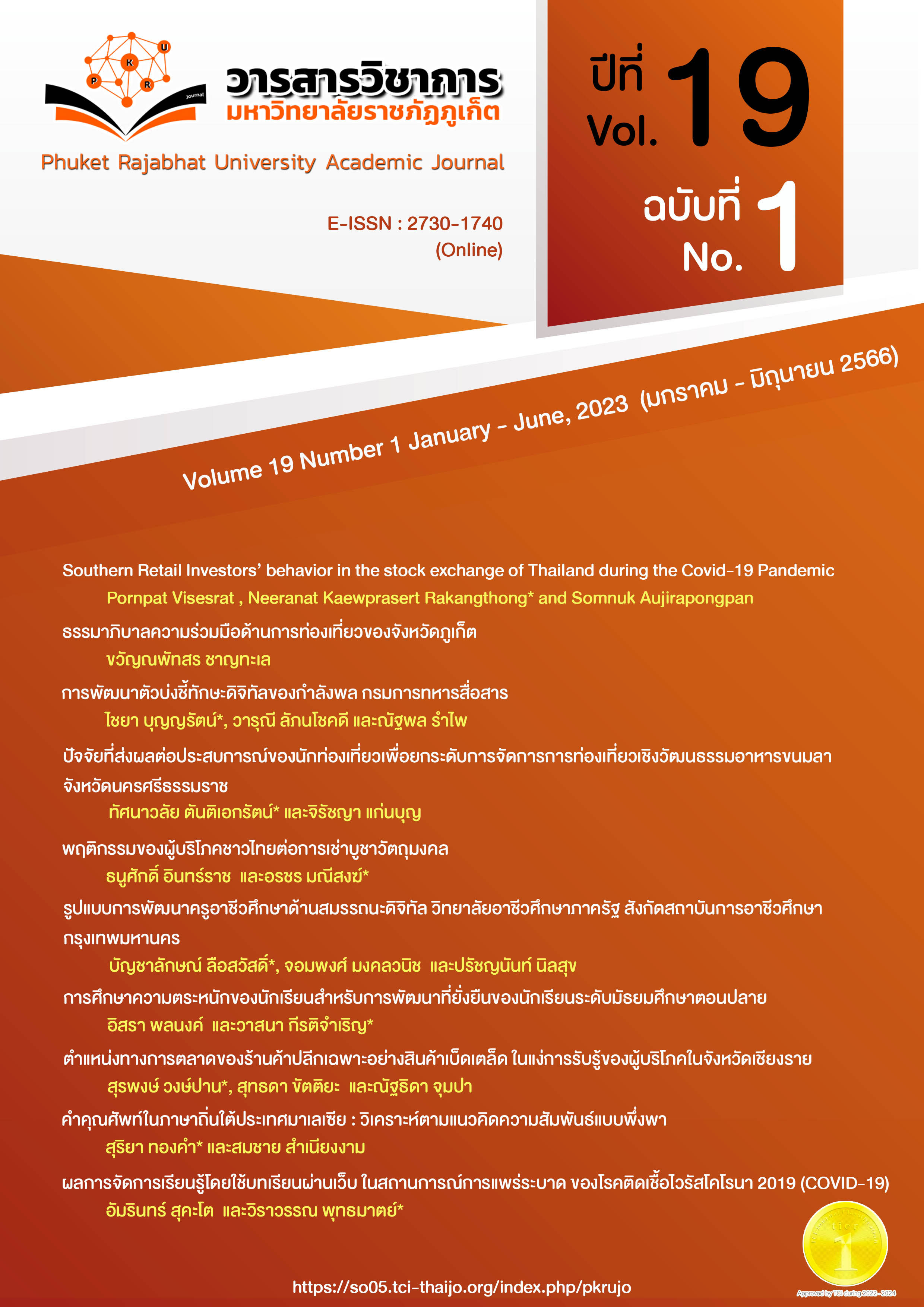รูปแบบการพัฒนาครูอาชีวศึกษาด้านสมรรถนะดิจิทัล วิทยาลัยอาชีวศึกษาภาครัฐ สังกัดสถาบันการอาชีวศึกษากรุงเทพมหานคร
Main Article Content
บทคัดย่อ
การศึกษาครั้งนี้มีวัตถุประสงค์เพื่อพัฒนาและประเมินรับรองรูปแบบการพัฒนาครูอาชีวศึกษาด้านสมรรถนะดิจิทัล วิทยาลัยอาชีวศึกษาภาครัฐ สถาบันการอาชีวศึกษากรุงเทพมหานคร เป็นการวิจัยแบบผสานวิธีระหว่างการวิจัยเชิงคุณภาพและการวิจัยเชิงปริมาณ ทำการพัฒนารูปแบบด้วยวิธีการสนทนากลุ่มโดยผู้ทรงคุณวุฒิ จำนวน 7 คน ประเมินความเหมาะสมและรับรองรูปแบบโดยผู้ทรงคุณวุฒิ จำนวน 13 คน และสถิติที่ใช้ในการวิเคราะห์ข้อมูล ได้แก่ ค่าเฉลี่ย และส่วนเบี่ยงเบนมาตรฐาน ผลการวิจัยพบว่า รูปแบบการพัฒนาครูอาชีวศึกษาด้านสมรรถนะดิจิทัล วิทยาลัยอาชีวศึกษาภาครัฐ สังกัดสถาบันการอาชีวศึกษากรุงเทพมหานคร แบ่งเป็น 3 ส่วน 5 ขั้นตอน ได้แก่ ส่วนที่ 1 ข้อมูลนำเข้า มี 1 ขั้นตอน ได้แก่ ขั้นตอนที่ 1 การวิเคราะห์ความสามารถ ส่วนที่ 2 กระบวนการดำเนินงาน มี 4 ขั้นตอน ได้แก่ ขั้นตอนที่ 2 วิเคราะห์สาเหตุ ขั้นตอนที่ 3 การออกแบบและเลือกวิธีการผลักดัน ขั้นตอนที่ 4 การผลักดันให้สำเร็จและเกิดการเปลี่ยนแปลง และขั้นตอนที่ 5 การประเมินผล และส่วนที่ 3 ผลผลิต ได้แก่ สมรรถนะดิจิทัล 12 หลักสูตร ได้แก่ 1) หลักสูตรการรู้ดิจิทัล 2) หลักสูตรคอมพิวเตอร์เบื้องต้น 3) หลักสูตรอินเทอร์เน็ตเบื้องต้น 4) หลักสูตรการป้องกันความปลอดภัยสำหรับคอมพิวเตอร์เบื้องต้น 5) หลักสูตรการใช้งานโปรแกรมประมวลผลคำ 6) หลักสูตรการใช้งานโปรแกรมตารางคำนวณ 7) หลักสูตรการจัดการงานนำเสนอ 8) หลักสูตรการประยุกต์การทำงานผ่านระบบออนไลน์ 9) หลักสูตรการประยุกต์การทำงานผ่านเว็บไซต์ 10) หลักสูตรการป้องกันภัยคุกคามบนระบบเครือข่าย 11) หลักสูตรดิจิทัลเพื่อการเปลี่ยนแปลงโลกอาชีพ และ 12) หลักสูตรการปรับตัวการเปลี่ยนแปลงดิจิทัล และผลการประเมินความเหมาะสมและรับรองรูปแบบ พบว่า ผู้ทรงคุณวุฒิให้การรับรองรูปแบบ โดยองค์ประกอบของรูปแบบและรูปแบบการพัฒนาครูอาชีวศึกษาด้านสมรรถนะดิจิทัล วิทยาลัยอาชีวศึกษาภาครัฐ สังกัดสถาบันการอาชีวศึกษากรุงเทพมหานคร มีความเหมาะสมระดับมากที่สุด
Article Details

อนุญาตภายใต้เงื่อนไข Creative Commons Attribution-NonCommercial-NoDerivatives 4.0 International License.
เนื้อหาและข้อมูลในบทความที่ลงตีพิมพ์ในวารสารวิชาการมหาวิทยาลัยราชภัฏภูเก็ต ถือเป็นข้อคิดเห็นและความรับผิดชอบของผู้เขียนบทความโดยตรง ซึ่งกองบรรณาธิการวารสารฯ ไม่จำเป็นต้องเห็นด้วยหรือร่วมรับผิดชอบใด ๆ
บทความ ข้อมูล เนื้อหา รูปภาพ ฯลฯ ที่ได้รับการตีพิมพ์ในวารสารวิชาการมหาวิทยาลัยราชภัฏภูเก็ต ถือเป็นลิขสิทธิ์ของวารสารวิชาการมหาวิทยาลัยราชภัฏภูเก็ต หากบุคคลหรือหน่วยงานใดต้องการนำทั้งหมดหรือส่วนหนึ่งส่วนใดไปเผยแพร่ต่อหรือเพื่อกระทำการใด ๆ จะต้องได้รับอนุญาตเป็นลายลักษณ์อักษรจากวารสารวิชาการมหาวิทยาลัยราชภัฏภูเก็ตก่อนเท่านั้น
เอกสารอ้างอิง
Binbai, S. (2015). Competency, Skills and Roles of Thai Teachers in the 21st Century. Teacher Training College. Phranakhon Rajabhat University.
Chamornman, U. (1998). Creation and development of a test to select people to work. HR Center.
Duangchinda, W. (2014). Google Apps for Education to the world of education in the new era to the success of Thai higher education and ASEAN online learning steadily. Retrieved February 20th, 2021 form http://support.thaicyberu.go.th
Europe Commission. (2014). The Digital Competence Framework 2.0. Available from https://ec.europa.eu/jrc/en/digcomp/digital-competence-framework
Institute of Professional Qualifications. (2018). Announcement of the Board of Professional Qualifications Re: Competency Development in Digital Use. Retrieved from http://www.ratchakitcha.soc.go.th/
Institute of Vocational Education Bangkok. (2021). Institutional Administrative Strategy. Retrieved from https://www.iveb.ac.th/th/about_us/strategy
Laohacharasang, T. (2017), March). Characteristics of learners in the 21st Century. Retrieved February 20th, 2021 form https://www.youtube.com/watch?v=EIho NcfszmV
Learn Education. (2021). The Competence of Teachers in the 21st century as determined by the Ministry of Education. Retrieved February 20th, 2021 form https://www.learneducation.co.th
Lerttharathat, N. (2017). Learning in the digital age and human resources development in science and technology to prepare for Thailand 4.0. Journal of the Department of Science Service. 65(205), 10-11.
MAC Education. (2020). 21st Century Vocation Teacher. Green Apple Graphic Printing.
Muangklam, S. (2019). A Component Analysis of Digital Competence of Teachers and Educational Personnel. Rajamangala University of Technology Thanyaburi.
Nadler,L. & Wiggs, G.D. (1989). Managing Human Resources Development. Jossey-Bass.
National Development Research Institute Foundation. (2018). Final Report Digital Manpower Development of study Project to Support Targeted industries (S-Curve) and Eastern Economic Corridor (EEC) Development. Retrieved February 20th, 2021 form https://tdri.or.th/wp-content/uploads/2018/09/
Ngernpoolsab, S. & Pakdejed, R. (2021). Human resource development model of Rajamangala University of Technology Rattanakosin in the era of Thailand 4.0. Journal of Administrative and Management Innovation. 9(1), 69-78.
Nilsook, P. (2012). Technology to enhance human performance (Human Performance Technology). Retrieved February 20th, 2021 form https://www.gotoknow.org/posts/43048
Office of the Education Council Secretariat. (2011). Thailand's Manpower Production and Development Strategy in Education Reform in the Second Decade 2009-2018. Office of the Education Council Secretariat.
Office of the Education Council Secretariat. (2020). The Development of Digital Mass Communication Officer’s Core-Competency Indicators by Using Delphi Techniques. Office of the Education Council Secretariat.
Office of the Federal Government. (2020). What is Digital Literacy? Retrieved February 20th, 2021 form https://www.ocsc.go.th/DLProject/mean-dlp
Office of the National Digital Economy and Society Commission. (2020). Digital Competency Framework for Thai Pons. Office of the National Digital Economy and Society Commission Digital Ministry for Economy and Society.
Office of the Vocational Education Commission. (2015). Policies, goals, strategies for developing vocational manpower over a period of 15 years (2012-2024). Retrieved February 20th, 2021 form http://www.lampangpoly.ac.th/main/attachments/
Office of the Vocational Education Commission. (2017). Vocational Education Development Plan 2017-2036. Office of the Vocational Education Commission Ministry of Education.
Pandam, S. (2020). Turn the crisis into an opportunity for Thai vocational education on the new normal. Journal of Buddhist Social Sciences and Anthropology. 5(7), 1-13.
Pantapangkul, P. (2015). Methods of employee development. Retrieved February 20th, 2021 https://prakal.com/author/prakal/
Papattha, C., Preawprasit, S., and Trakulwong, W. (2021). Confirmatory Component Analysis of Digital Vocational Teacher Competencies to Support Thailand 4.0 Policy. Journal of Research and Innovation. Institute of Vocational Education Bangkok. 4(2), 72-107.
Phrommanee, P., Iamsaa, S. & Krasang, P. (2017). Guideline to Construct and Development Model for Public Health Operations for Public Health Officer. Journal of the Association of Private Higher Education Institutions of Thailand under the Royal Patronage of HRH Princess Maha Chakri Sirindhorn Her Royal Highness Princess Maha Chakri Sirindhorn. 6(2), 128-135.
Priaoprasit, S. (2016). “Google Applications” educational innovations for vocational education. Journal of Mass Communication Technology, RMUTP. 1(1), 87-91.
Promwong, C. (2011). Steps to change educational innovation through research and development. Retrieved February 20th, 2021 https://webportal.bangkok.go.th/upload/user/00000116/4-techno/article/1-academic/41.pdf
Rajamangala University of Technology Phra Nakhon. (2019). Guidelines for the development of competency systems for the development of human resource management. Retrieved March 25th, 2022 from https://competency.rmutp.ac.th/competency-assessment/
Secretariat of the Education Council. (2020). Developing a model of human resource development in digital competency according to the Thailand 4.0 policy. Secretariat of the Education Council.
Siripala, W. (2016). The Rajabhat model of teacher’s professional development. [Doctoral dissertation]. Siam University.
Suparan, K. (2020). Teacher Skills and the New Era of Online Learning Management. Retrieved February 20th, 2021 form https://www.educathai.com/knowledge/articles/372
Suwannawong, A. (2021). New breed of vocational teacher competency according to teacher perception during the epidemic of COVID-19: a case study of Lopburi Province. Panyapiwat Journal. 13(3), 179-190.
Techsauce. (2018). Education Disruption: How Will Teachers Adapt in a Changing World? Retrieved February 20th, 2021 form https://techsauce.co/tech-and-biz/teachers-the-future-in-education-disruption
Thienput, D. (1994). Human Development Strategy: Challenges to Business Success. Chulalongkorn University.
TRIS Academy. (2021). Cybersecurity Awareness. Retrieved February 20th, 2021 from https://www.tris.co.th/tag/digital-transformation/
Vadakovido, P.P. (2018). A Model of Developing an Ideal Expert in Peace by Buddhist Peaceful Means. [Doctoral dissertation]. Mahachulalongkornrajavidyalaya University.
Wattanasongyot, P. (2013). The Use of Information Technology in Training for Success. Retrieved February 20th, 2021 from https://www.stou.ac.th/study/sumrit/3-60/page4-3-60.html
Wongyai, W. & Pattaphol, M. (2021). Digital competence. Srinakharinwirot University.


